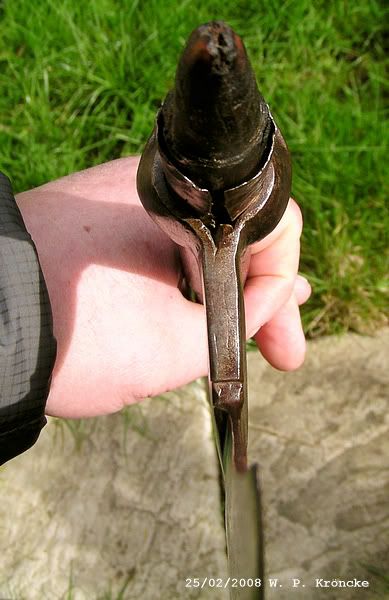
 |
|
|
|
|
#1 |
|
Member
Join Date: Oct 2007
Posts: 1,644
|
Hi Jim,
Thanks for the info as always. The history of these axes eludes me and I was hoping that some of the more experienced members might be able to flesh out the bones a little more. The net seems quite dry on this subject. Whilst I cannot add anything regarding the history and possible uses of these axes I have been able to find a number of pictorial examples on the net and there appears to be quite a difference from example to example both in quality of construction and design. The most numerous types seem to be the 'moustache' shaped blades which I don't think make the most of the 'axe concept' the force of the blow being dissipated along the length of the blade rather than concentrated in one section to make the most of the 'strike'. The one I have, and this is what attracted me in the first place, appears to have been designed for one purpose to maximise the effect of a blow. The blade has a gradual distal taper from the root of the blade to the edge with a pronounced central ridge running the full width. The ball on the shaft adds extra weight and is directly above the central point of the blade ensuring that maximum force is concentrated on the small central section of the blade for greater effect. Whether intentional or not the ball at the base of the blade could be used, I imagine, as an effective tool for crushing armour emulating the action of a mace. The effectiveness of some of the other blade profiles I've seen would appear to be somewhat compromised by their flamboyance although not having one to handle I cannot be absolutely sure. The preponderance of the 'moustache' type blades also makes me think that I might have missed something that makes them more suitable for purpose than it would first appear. I am interested in other members thoughts and hope that some might post examples that they may have in their collections. Regards to All, Norman. |
|
|

|
|
|
#2 |
|
Member
Join Date: Mar 2006
Location: Room 101, Glos. UK
Posts: 4,249
|
Mine has a more traditional axe shape,
 these seem to be designed for maximum cutting effectiveness on un-armoured opponents, and could be used in a slicing style of attack. they are from central india and i expect the heat and humidity would make armour uncomfortable and predispose them to a more lightweight and fast combat style. the rattan shafts are light and very strong for their weight. Here is a gatka axe fight Another axe demo Last edited by kronckew; 5th August 2008 at 04:41 PM. |
|
|

|
|
|
#3 |
|
Member
Join Date: Oct 2007
Posts: 1,644
|
Hi Wayne,
Your axe is similar to mine in that the edge is convex and the weighty bulbous part is in line with the centre of the blade where one would assume the maximum cutting force would be found, I was wondering how effective the ones with the concave centre section were, as far as I can see there is no advantage to the concave ones in fact the reverse i.e. not as effective. I see also that yours could in fact be used in a stabbing motion much like some European polearms. Thanks again. My Regards, Norman. |
|
|

|
|
|
#4 |
|
Member
Join Date: Mar 2006
Location: Room 101, Glos. UK
Posts: 4,249
|
i've seen illustrations of them with concave, straight, convex and multi-pointed shapes, rectangular, etc. googling 'bullova axe' & selecting the images will bring up a bewildering variety, like this image i found googling:
not sure how that was intended to be used either, looks like it might stick in the target...the more usual moustache ones  were noted on one indian blog as being notched in the middle to fit an intended victims neck, tho this seems unlikely to me. not a lot out on the ol' internet... i read somewhere that the earlier ones were made in two parts, the blade part being riveted to the neck of the eye part, the later ones forged in one piece. in mine it appears the eye & neck were one piece, and the blade and it's neck piece were inserted and hammer forged together, you can see the layers in the following: 
|
|
|

|
|
|
#5 |
|
Member
Join Date: Oct 2007
Posts: 1,644
|
Hi Wayne,
I read somewhere the multi spiked variety were intended to go through mail, maybe, maybe not. The neck thing, as you say, seems most unlikely. Regards, Norman. |
|
|

|
 |
|
|